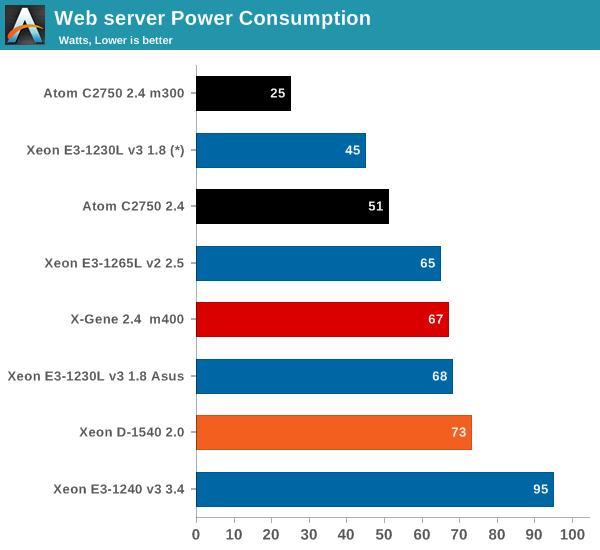The Intel Xeon D Review: Performance Per Watt Server SoC Champion?
by Johan De Gelas on June 23, 2015 8:35 AM EST- Posted in
- CPUs
- Intel
- Xeon-D
- Broadwell-DE
Web Infrastructure Power consumption
Next we tested the system under load.

(*) measured/calculated to mimic a Xeon-E3 "m300-ish" board.
Let us entangle the results by separating the power that goes to the SoC and the power that goes to the system. We did a similar though experiment in our X-Gene 1, Atom C2000 and Xeon E3 comparison.
| Power Consumption SoC Calculations | ||
| SoC | Power Delta = Power Web - Idle (W) |
Power SoC = Power Delta + Idle SoC + Chipset (W) |
| Xeon E3- 1240 v3 3.4 | 95-42 = 53 | 53+3+3 = 59 |
| Xeon E3-1230L v2 1.8 | 68-41 = 27 (45-18 = 27) |
27+3+3 = 33 |
| Xeon D-1540 | 73-31 = 42 | 42+2+0 = 44 |
| Atom C2750 2.4 | 25-11 = 13 | 13+3+0 = 16 |
Now let us combine our calculated SoC power consumption and the power measurements in the graph above. The Atom C2750 still make sense in a micro server if CPU performance is not a priority: think static webservers and caching servers. You can fit an Atom C2750 server inside a power envelop of 25W as HP has proven. Based upon our own experience, such a Xeon D system would probably require more like 55 - 60 W.
If CPU performance is somewhat important, the Xeon D is the absolute champion. A Xeon E3-1230L server with similar features (2x 10 Gb for example) will probably consume almost the same amount of power as we have witnessed on our Asus P9D board (68 W). Given a decently scaling application with enough threads or some kind of virtualization (KVM/Hyper-V/Docker), the Xeon D server will thus consume at most about 1/3 more than an Xeon E3-1230L, but deliver almost twice as much performance.










90 Comments
View All Comments
julianb - Saturday, October 31, 2015 - link
Thanks for the reply, man.And sorry for my late reply, totally forgot about this thread :)
eva2000 - Tuesday, June 23, 2015 - link
Nice... Xeon D-1540 is awesome, but I wish it was clocked 0.2Ghz higher across the board would be just enough to tip that scale versus E5. Did my own benchmarks at https://community.centminmod.com/threads/2864/ :)extide - Wednesday, June 24, 2015 - link
Thats probably exactly why it ISNT clocked 0.2Ghz higher across the board ;)I'm sure Intel wants to see some space between this and E5.
boogerlad - Tuesday, June 23, 2015 - link
If this was marketed for the consumer market with the ability to overclock, this would outsell everything completely. This is what the enthusiast needs!!!Refuge - Tuesday, June 23, 2015 - link
I don't think this is going to do much of anything for an enthusiast.Unless they are interested in building a server for some experiment or project.
JohanAnandtech - Wednesday, June 24, 2015 - link
I still think the i7 59xx series is a better match for consumers: higher clocks and thus ST performance. The Xeon D most interesting features such as integrated 10 GBe and low power don't interest most performance consumers. Most people will have a hard time saturating a 1 GBe line and power savings are not a priority.tspacie - Wednesday, June 24, 2015 - link
Seems to tick all the boxes for a software development machine. Very good at compilation. Reasonably priced for the performance. Low power. ECC memory. I'm temptedextide - Wednesday, June 24, 2015 - link
EXACTLY what I was thinking!MrSpadge - Saturday, June 27, 2015 - link
I would be very tempted by such a chip as well, using it for BOINC. However, Broadwell looses some of the power efficiency advantage if you push it harder, i.e. the largest gains are at low and moderate frequency. Perfect for such server chips and mobile ones, but not so much for people aiming for 4+ GHz.MaxKreimerman - Tuesday, June 23, 2015 - link
Sounds impresive in just 45w package, but imposible to find in the retail sites such as newegg or wiredzone